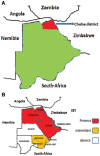Thermal Biology and Seasonal Population Abundance of Bactrocera dorsalis Hendel (Diptera: Tephritidae): Implications on Pest Management
- PMID: 31488955
- PMCID: PMC6710710
- DOI: 10.1177/1179543319863417
Thermal Biology and Seasonal Population Abundance of Bactrocera dorsalis Hendel (Diptera: Tephritidae): Implications on Pest Management
Abstract
Since the first detection of Bactrocera dorsalis in Botswana in 2010, the establishment, spread, and response to prevailing Botswana microclimates under rapidly changing environments remain unknown. This study investigated the presence, seasonal population abundance, and thermal biology of B. dorsalis in Botswana. We measured B. dorsalis thermal tolerance vis critical thermal limits (CTLs) and lethal temperature assays (LTAs) to understand how temperature largely impacts on fitness and hence invasive potential. Seasonal monitoring results indicated B. dorsalis establishment in the Chobe district (its first area of detection). Trap catches showed continuous adult flies' presence all year round and high average monthly trap catches as compared with other districts. Furthermore, B. dorsalis was detected south of Botswana, including Kgatleng, Kweneng, South-east, and Southern districts. Critical thermal maxima (CTmax) to activity for adults and larvae were 46.16°C and 45.23°C, whereas critical thermal minima (CTmin) to activity for adults and larvae were 9.1°C and 7.3°C, respectively. Moreover, we found an improved CTmin for larvae at a slower ramping rate, indicating potential rapid cold hardening. The lower lethal temperature (LLT) and upper lethal temperature (ULT) assays revealed a reduction in survival at all the developmental stages as severity and duration of both temperature extremes increased. Microclimatic temperatures recorded in Botswana showed that environmental temperatures fall within the thermal breath of B. dorsalis activity measured here, indicating a potential conducive climate niche for the insect pest across the country, albeit other factors, e.g., host availability, play a significant role. These results therefore suggest that Botswana microclimatic temperatures aided B. dorsalis activity and invasion pathway are thus significant in mapping invasions and pest risk analysis, and may also aid in designing pest management strategies.
Keywords: Asian fruit fly; climate change; insect phenology; invasive insect species; population dynamics; thermal tolerance.
Conflict of interest statement
Declaration of conflicting interests:The author(s) declared no potential conflicts of interest with respect to the research, authorship, and/or publication of this article.
Figures





References
-
- White IM, Elson-Harris M. Fruit Flies of Economic Significance Their Identification and Bionomics. Wallingford, UK: CAB International; 1994:433.
-
- Clarke AR, Armstrong KF, Carmichael AEet al. Invasive phytophagous pests arising through a recent tropical evolutionary radiation: the Bactrocera dorsalis complex of fruit flies. Annu Rev Entomol. 2005;50:293–319. - PubMed
-
- Follett PA, Neven LG. Current trends in quarantine entomology. Annu Rev Entomol. 2006;51:359–385. - PubMed
-
- Ekesi S, Nderitu PW, Chang CL. Adaptation to and small-scale rearing of invasive fruit fly Bactrocera invadens (Diptera: Tephritidae) on artificial diet. Ann Entomol Soc Am. 2007;100:562–567.
-
- Standards Trade Development Facility. A co-ordinated multi-stakeholder approach to control fruit fly in West Africa. STDF Briefing No. 4. https://www.standardsfacility.org/sites/default/files/STDF_Briefing_No4_.... Up-dated January 2010.
LinkOut - more resources
Full Text Sources

